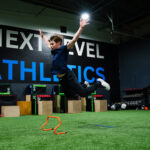Using Speed and Agility Training for Faster Recovery
When most people think of speed and agility, they picture explosive drills and peak athletic performance. But what many don’t realize is that these movements — when scaled properly — are powerful tools for recovery.
Whether you’re coming back from a sprained ankle, ACL surgery, or general deconditioning, properly programmed speed and agility training can help you return to sport stronger, more stable, and better coordinated.
Let’s break down how this works — and how to use it safely in your recovery journey.
Why Speed and Agility Matter During Recovery
Injury doesn’t just affect strength or flexibility. It also impacts:
-
Neuromuscular control
-
Balance and coordination
-
Confidence in movement
-
Sport-specific timing
By gradually reintroducing agility and speed-based patterns, athletes rebuild movement skills, not just muscles.
More importantly, this form of training bridges the gap between rehab and return-to-play — where most athletes get stuck.
How to Use Speed and Agility During Recovery
1. Start with Controlled, Low-Impact Drills
Speed and agility doesn’t mean intensity — it means patterning.
Early in recovery, athletes should focus on:
-
Slow ladder drills for foot placement
-
Light cone work for directional control
-
Shadow drills for visual reaction without contact
These reintroduce athletic movement in a low-risk way.
2. Progress Timing, Not Just Load
Most recovery plans focus on strength or mobility. But if you want to return to game speed, your drills need to include timing and reactivity.
For example:
-
Move from cone-to-cone walking → shuffling → quick stepping
-
Add a visual cue (e.g., colored cone or light) to re-engage reaction time
-
Increase unpredictability once movement is pain-free
This approach restores real-world readiness without rushing the body.
3. Reinforce Symmetry and Control
Many injuries create imbalances. Athletes unconsciously favor the healthy side.
Agility drills help reveal and correct these issues:
-
Use mirror drills to promote bilateral coordination
-
Perform single-leg deceleration drills
-
Include movement reviews via video or coaching feedback
This prevents compensations that often cause re-injury.
Recovery Phases and Agility Integration
Here’s how to structure speed and agility across three recovery phases:
Phase 1: Mobility + Motor Relearning (0–4 weeks post-clearance)
-
Ladder drills at walking pace
-
Short shuffle steps
-
Isolated cone touches
-
3–4 drills, 15–30 seconds each
-
Focus: Pattern, pain-free motion, low impact
Phase 2: Stability + Control (4–8 weeks)
-
Add lateral bounds to a line
-
Partner shadow movement drills
-
Backpedal → decelerate into cone touch
-
Introduce reaction cues
-
Focus: Single-leg control, reaction, balance
Phase 3: Pre-Return to Play (8+ weeks)
-
React-to-light sprints
-
Short burst cuts
-
Decision-based agility (verbal/visual cues)
-
Focus: Speed with decision-making under pressure
Always coordinate this with a sports PT or performance coach.
Real-Life Example: ACL Recovery Progression
An athlete recovering from ACL surgery might progress through:
-
Week 1–3: Ladder drills at walking speed, lateral steps
-
Week 4–6: Cone drills with slow cutting angles, core engagement
-
Week 7–10: Short reactive drills, partner mirror agility
-
Week 11+: Live change of direction under reaction stimulus
This method restores both physical and mental readiness.
Speed and Agility Training Supports Mental Recovery
Coming back from injury isn’t just physical — it’s psychological.
Athletes often lose confidence in their body. Controlled agility drills:
-
Provide safe exposure to previous injury movements
-
Help rebuild trust in motion
-
Offer a measurable sense of progress
These are critical for a full, lasting return to sport.
Why Work With a Coach?
At Next Level Athletics, recovery training includes speed and agility even before full-speed sprinting resumes. Coaches modify drills to meet the athlete’s stage of healing — ensuring growth without overload.
They also use tools like video breakdowns, progress metrics, and neurocognitive feedback to build complete return-to-play readiness.
The Science of Movement Re-Education
Research from Healthline supports exercise as a key pillar in injury recovery. Speed and agility training works by:
-
Rebuilding neuromuscular pathways
-
Enhancing blood flow for tissue healing
-
Reintroducing functional movement patterns
-
Supporting cognitive-motor coordination
This makes agility not just helpful — but essential in many rehab plans.
Final Thoughts: Recovery Is an Athletic Skill
Recovery isn’t passive. It’s a skill that can be trained, sharpened, and accelerated.
Speed and agility drills — when used intentionally — help athletes reconnect with their sport, retrain their bodies, and reduce re-injury risk. It’s not about intensity — it’s about intention.
So don’t wait until you’re 100% to move like an athlete again. Move smart. Move controlled. And move with purpose.


Recent Comments